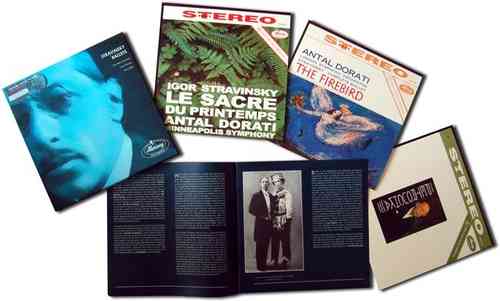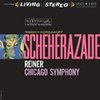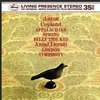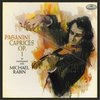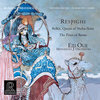Speakers Corner / Mercury - 180 Gram Virgin Vinyl -
Limited Edition - Pure Analogue Audiophile Mastering - Pressed at Pallas Germany
Deluxe 3 Disc Box Set - SR90253 SR90226 SR90216
AAA 100% Analogue This LP was Remastered using Pure Analogue Components Only, from the Master Tapes through to the Cutting Head
Three famous and famous-sounding ballets by Stravinsky, all conducted by Antal Dorati - packaged together by Speakers Corner. Includes slip case and deluxe 12 page booklet.
"…I consider all three of these ballets to be 'must haves' in any classical musical library and the re-emergence of these now readily available and rejuvenated recordings is a cause for serious celebration…demonstration quality sound that is, in my opinion, harmonically and tonally near perfect, and not to be confused with the earlier Classic Records release…Speakers Corner Records has once again delivered a winning combination of performance, pressing quality and presentation. This set should be a keystone in every serious collection. Actually, let's make that every collection, period. These records really are too good to miss." – Richard S. Foster, Hi-Fi+,
A true revelation. Is this Speaker Corner album another legend in the making? Time will tell. Right now it deserves a Blue Moon Award. - 6Moons
"There's plenty of depth and imaging is naturally specific. instrumental timbres are richly characterized; violins are silky and the celesta sparkles. All three LPs have more timbral refinement and dimensionality than the excellent early 90s CD reissues." - Andy Quint, The Absolute Sound, October 2008, Issue 185
Musicians:
London Symphony Orchestra
Minneapolis Symphony Orchestra
Antal Dorati, conductor
Albums:
Mercury SR90216
TAS Rated 3/5 Music, 3/5 Sonics in the October 2008 Issue of The Absolute Sound!
Igor Stravinsky: Petrouchka/Antal Dorati/The Minneapolis Symphony Orchestra
Petrochka was born of Stravinsky’s vision of a long-haired musician hammering indiscriminately at the piano keys and engaging in a furious contest with the orchestra which answers with vehement protests and acoustic fisticuffs. As was the case with The Rite of Spring and The Firebird, Sergei Diaghilev and his Russian ballet had their share in ensuring that the “burlesque” in four scenes would be suitable for the stage.
The clown-doll Petrouchka revels in his spiteful teasing and pranks at the Shrovetide fair. The orchestra contributes swirling dance figures, blaring brass and scurrying strings to his high-spirited clownery – but then the Moor enters and dances with the Ballerina, arousing jealousy in Petrouchka. Although the clown-doll does not survive this bitter-sweet story, he triumphs at the end, his ghost mocking the crowd at the fair.
This highly inventive music combines folksong, popular music and the waltz, all bound together by exhilarating rhythms which are often taken to thunderous extremes. With its outstanding sound, this recording is a must-have in any Stravinsky collection.
Mercury SR90226
TAS Rated 4/5 Music, 3.5/5 Sonics in the October 2008 Issue of The Absolute Sound!
Igor Stravinsky: The Firebird/Antal Dorati/The London Symphony Orchestra
The Firebird can almost be described as a work of fate, since it is not only the first of several ballets that Stravinsky wrote for Sergei Diaghilev and his Ballets Russes but also marks his international breakthrough as a composer. In comparison with his other earlier stage works, the ecstatic, sharply contoured Rite of Spring for example, The Firebird, with its melodic character, is a far gentler work altogether. There are unmistakable reminiscences of the musical language of Rimsky-Korsakov and Tchaikovsky as well as snatches of late-Romantic harmonies; all this lends the music the charm of Russian tradition.
In his performance, Dorati chooses the golden mean in that he has his ensemble produce a highly colorful but by no means glaring sound. Thus the listener is given the opportunity to follow the development of the finely chiseled motifs which are so characteristic of this early composition. Happily, the chamber-music-like transparency is preserved even in the loud, more exposed passages – the sound leaves the loudspeakers with a sprightly, athletic tread, as it were.
Mercury SR90253
TAS Rated 4.5/5 Music, 4.5/5 Sonics in the October 2008 Issue of The Absolute Sound!
Igor Stravinsky: The Rite of Spring/Antal Dorati/The Minneapolis Symphony Orchestra
While he was finishing the score of The Firebird, the idea came to Stravinsky for a pagan, ritual scenario. The background history of Le Sacre du printemps is well known: while the modernists praised the work, the conservative public thought they were being hoaxed. The reason for their irritation and the scandalous fiasco of the premiere is still audible to this day. Stravinsky carries the aggressive, hammering rhythms to the extreme, casting them in atonal harmonies which feed on the alternation between a red-hot and a mild mixture, as Stravinsky put it.
Dorati urges on his ensemble with robust tempi, and the orchestra is quick to respond to all the refinements of the tightly knit movement. It appears to cope effortlessly with the extremes of contrast and manages to amalgamate the rhythmic excesses with the tenderness of the numerous tiny motifs and figures which seem to sprout like flowers out of hard rock. The excellent recording technique captures both the extreme loudness and the finely pulsating tones, resulting in a sound in which no detail goes unheard. The listener can be sure that this Stravinsky deserves the rating "excellent" – both for the interpretation and for the sound.
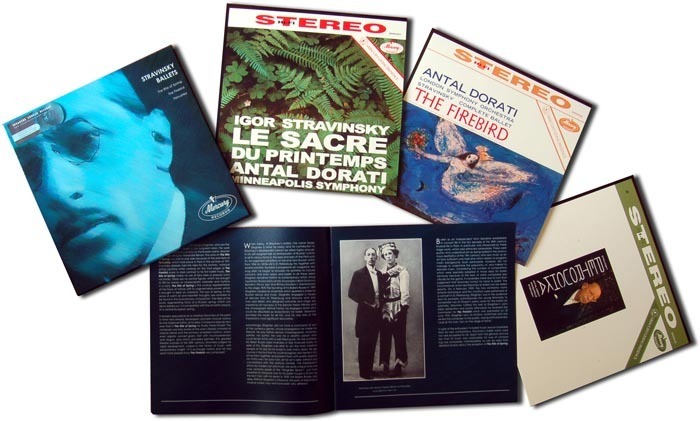
Are your records completely analogue?
Yes! This we guarantee!
As a matter of principle, only analogue masters are used, and the necessary cutting delay is also analogue. All our cutting engineers use only Neumann cutting consoles, and these too are analogue. The only exception is where a recording has been made – either partly or entirely – using digital technology, but we do not have such items in our catalogue at the present time
Are your records cut from the original masters?
In our re-releases it is our aim to faithfully reproduce the original intentions of the musicians and recording engineers which, however, could not be realised at the time due to technical limitations. Faithfulness to the original is our top priority, not the interpretation of the original: there is no such thing as a “Speakers Corner Sound”. Naturally, the best results are obtained when the original master is used. Therefore we always try to locate these and use them for cutting. Should this not be possible, – because the original tape is defective or has disappeared, for example – we do accept a first-generation copy. But this remains an absolute exception for us.
Who cuts the records?
In order to obtain the most faithful reproduction of the original, we have the lacquers cut on the spot, by engineers who, on the whole, have been dealing with such tapes for many years. Some are even cut by the very same engineer who cut the original lacquers of the first release. Over the years the following engineers have been and still are working for us: Tony Hawkins, Willem Makkee, Kevin Gray, Maarten de Boer, Scott Hull, and Ray Staff, to name but a few.
At the beginning of the ‘90s, in the early days of audiophile vinyl re-releases, the reissue policy was fairly straightforward. Companies such as DCC Compact Classics, Mobile Fidelity, Classic Records and others, including of course Speakers Corner, all maintained a mutual, unwritten code of ethics: we would manufacture records sourced only from analogue tapes.
Vinyl’s newfound popularity has led many other companies to jump on the bandwagon in the hope of securing a corner of the market. Very often they are not so ethical and use every imaginable source from which to master: CDs, LPs, digital files and even MP3s.
Even some who do use an analogue tape source employ a digital delay line, a misguided ’80s and ‘90s digital technology that replaces the analogue preview head originally used to “tell” the cutter head in advance what was about to happen musically, so it could adjust the groove “pitch” (the distance between the grooves) to make room for wide dynamic swings and large low frequency excursions. Over time analogue preview heads became more rare and thus expensive.
So while the low bit rate (less resolution than a 16 bit CD) digital delay line is less expensive and easier to use than an analogue “preview head”, its use, ironically, results in lacquers cut from the low bit rate digital signal instead of from the analogue source!
Speakers Corner wishes to make clear that it produces lacquers using only original master tapes and an entirely analogue cutting system. New metal stampers used to press records are produced from that lacquer. The only exceptions are when existing metal parts are superior to new ones that might be cut, which includes our release of “Elvis is Back”, which was cut by Stan Ricker or several titles from our Philips Classics series, where were cut in the 1990s using original master tapes by Willem Makkee at the Emil Berliner Studios. In those cases we used only the original “mother” to produce new stampers.
In addition, we admit to having one digital recording in our catalogue: Alan Parsons’ “Eye in the Sky”, which was recorded digitally but mixed to analogue tape that we used to cut lacquers.
In closing, we want to insure our loyal customers that, with but a few exceptions as noted, our releases are “AAA”— analogue tape, an all analogue cutting system, and newly cut lacquers.
